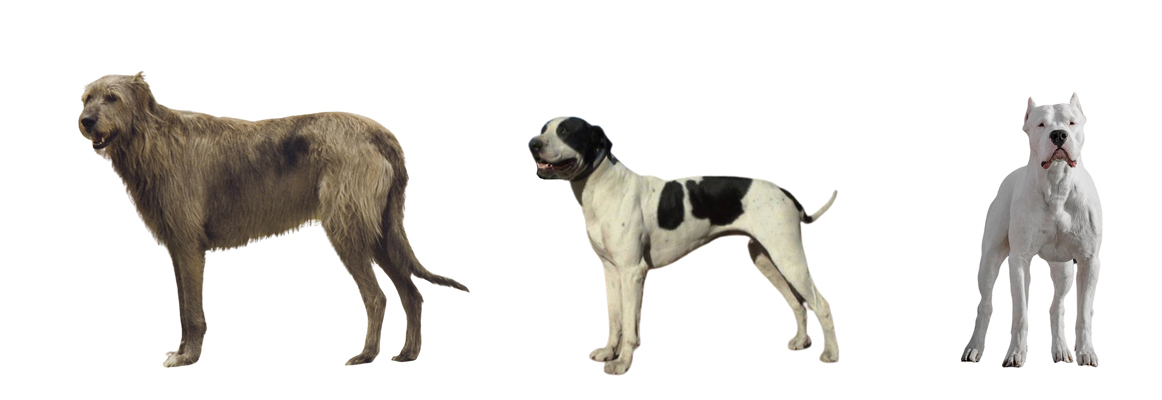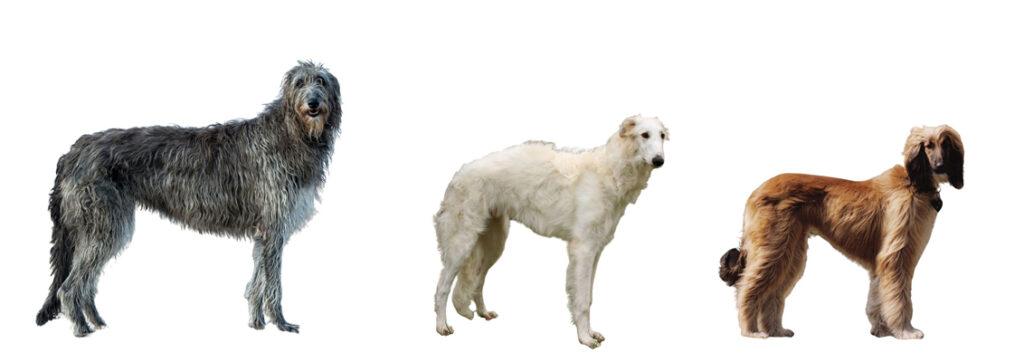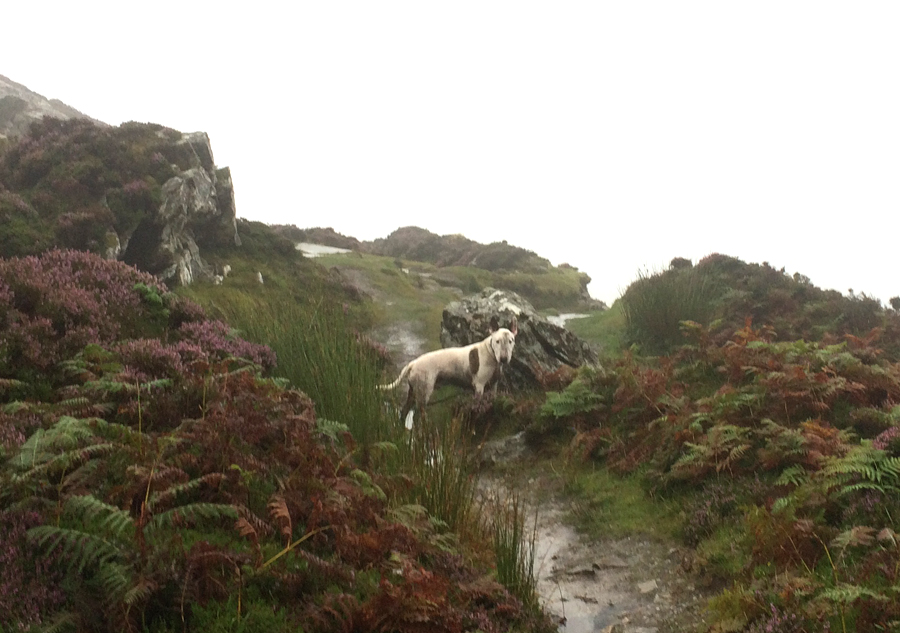While Hiking, you rarely see the really big dog breeds on the trails. I’m wondering if they would be great hiking companions or does their size cause limitations while hiking. I have studied the extra large dog breed group to find out which breeds are the best on the hiking trails.
Most Giant Dog Breeds can go on short easy hikes for about 3 miles or 5k . However there are some extra large breeds that love a good hike more then the rest. Here is the list of the best Giant or Extra Large Dog Breeds that are better suited for longer hikes.
- Irish Wolfhound
- Giant Alaskan Malamute
- Greater Swiss Mountain Dog
- Bull Arab
- Bernese Mountain Dog
- Dogo Argentino
- Scottish Deerhound
- Borzoi
- Afghan Hound


Many gentle giant canines were studied to find out the breeds that are best. See below which breeds made it in the varying categories. I have also found out that there are still limitations to the extra large dog breed group which you need to know before embarking on a hike or picking the perfect breed. In Addition, Picking the best hiking terrain for you and your dog is key to enjoying the outdoors with your extra large companion.
Can Giant Dog Breeds Go Hiking?
The answer is yes, but for how long? This is a more appropriate question. It depends on the breed of dog. I have classified these big breeds below, which are as follows:
Best Giant Breed for Hiking: 3+ hours on easy trails
Sturdy strong working dogs that were bred for pulling carts, sleds & caring packs and also hunting big game animals. These dogs, depending on the right environmental conditions they were bred for, do very well out on adventures for extended periods of time. Some I’ve found out can even go all day.
Breeds for Short to Medium hikes: 2+ hours
This group is mixed between mountainous breeds, livestock & property Guardians, and hunting breeds. Lots of Breaks are recommended and care is to be taken to check in with the individual needs of the dog.
Breeds for Short Hikes: 1 hour of walking or less than 5km / 3 miles of easy trails
Most extra large breeds can go on these short and easy hikes for 5 km or 3 miles or less. The breeds that make up this list are mostly the Mastiffs and the property or livestock guardians.
The Best Giant Dog Breeds for Hiking: 3+ Hours
The dogs that stand out to be the best hikers, are not surprisingly the hunting dogs of big game animals such as wild boar, pumas, leopards, gazelles, wolves, bears and deer. Such Breeds include:
- Scottish Deerhound
- Bull Arab
- Dogo Argentino
- Irish Wolfhound
- Borzoi
- Afghan Hound


Other breeds of our top picks also include breeds that were bred to be hard working in tough and often cold environments. These dogs were bred to pull carts, sleds and carry packs. They love to work and to be outdoors. These include:
- Giant Alaskan Malamute
- Greater Swiss Mountain Dog
- Bernese Mountain Dog

Both these groups of the big game hunters and mountain dogs absolutely love being in nature and don’t mind varying terrain with a challenge.
Buy these dogs a dog backpack as they really enjoy the challenge which allows them to fulfill their life’s purpose.
Short To Medium Hikes: 2+ Hours
These dog breeds are a mix of breeds that were mostly bred in mountainous areas or were guardians, hunting or rescue dogs. These dogs typically have medium energy levels and also love being outdoors.
They love to explore and be around water. It said that these dogs can do a plus 5 kilometers of an easy terrain hike but they do get tired and need rest along the way. It’s best for these dogs to take it easy with a relaxed walking pace to enjoy the outdoors. With each break, check to see how your dog is looking before proceeding as you don’t want to push them. These all round extra large breed dogs include:
- Newfoundland
- Leonberger
- Anatolian Shepherd Dog
- Cane Corso
- Presa Canario
- Kangal
- Great Pyrenees
- Saint Bernard


It’s important to note that historically some of these breeds were bred for the specific purpose of recuse, hunting and carting. In the past, these breeds could possibly go much further then the 2 hour recommendation. However modern breeding centered around dog aesthetics and not necessarily for breed purpose has caused some of these breeds to be ”softer” than their working ancestors.
Very Short Hikes: 1 Hour
These dogs consist of mainly mastiffs and guardian breeds. They were bred to watch over the home or livestock and make sure everyone was safe and protected. Some of these dogs have short bursts of high energy which prevent them from having more consistent energy that would sustain them on a long hike.
I have found out that these dogs enjoy nature more when you can find a scenic ‘drive up’ spot where you can let them out to run around and enjoy the space. For the trails I recommend only walking 1 hour easy flat trail and include some breaks along the way. These breeds include:
- Great Dane
- Tibetan Mastiff
- Bull Mastiff
- Bully Kutta
- Dogue de Bordeaux
- English Mastiff
- Tosa Inu
- Pyrenean Mastiff
- Fila Brasileiro
- Spanish Mastiff
- Neapolitan Mastiff
- Greyhound
- Boerboel


The Guarding Breeds
You may have not recognized some of the breeds mentioned in the list. This is because some of the breeds were bred for guarding of livestock and property and not originally for companionship. Some of these guardian breeds actually lived with the sheep or cattle to ward off thieves, wolves and foxes. In recent times, these breeds are becoming more popular and breeders are selecting for better companionship.
Typically, these breeds are described as being very independent from their owners and very hard to train, so best to start early and have them socialized with many people, animals and environments.
These dogs are also said to be not for first time dog owners, as they do better with an experienced dog handler. The other issue of these large Guardian breeds is that they are very standoffish, territorial and not trustworthy of strangers, which makes them perfect guard dogs, however not so perfect for off leash on the trails.
Socialize these dogs with many people, animals and environments from a young age and keep them on a leash when on the trails. these include:
- Tibetan Mastiff
- Great Pyrenees
- Anatolian Shepherd Dog
- Fila Brasileiro
- Pyrenean Mastiff
- Bully Kutta
- Kangal
- Spanish Mastiff


Picking The Right Trial For Your Giant Canine
Most of the extra large dog breeds suffer from hip, joint and knee problems especially in older age. Because of this, it’s important not to over exert your dog in any physical activity. Such issues include hip dysplasia, osteoarthritis, arthritis, dysplasia, osteochondritis and stiffness.
Only choose trails that are considered ‘Easy’ with low to moderate inclines.
Only choose trails that are rated as easy with low to moderate inclines. Hikes rated as medium are too challenging for most of these giant breeds and also most people.
It’s also important to note that I would not take any dog on a trail rated hard as this could be too dangerous for you and your dog.
Below is a quick guide produced by hikers in California which allows you to see what to expect on different grade hikes. Note if you are used to the Yosemite Decimal System then only choose Class 1:
Hiking Class & Grades
Easy / Beginner / Class 1 – can take toddlers and the elderly. Some inclines, no obstacles .
- All dogs will be able to do this depending on distance.
Moderate / Class 2 – Inclines, good fitness, strength, some mental stammer, hiking shoes recommended, increased distance, moderate experience, older children and teens and adults
- Some dogs breeds at a good age and fitness level.
Hard / Class 3 to 5 – Advanced level hikers only, very good fitness and strength needed, can last all day, ropes may be required or provided on the hike, hiking equipment and footwear required, No children, no teens, No Beginners.
- No Dogs
(It’s important to note that all levels require you to take water for you and your dog.)
Your Dog’s Individual Needs
It’s important to consider your dog’s individual needs before embarking on the hike.
Ask yourself how long do you normally walk your dog on a daily basis?
If your dog only gets a few walks a week then your dog is probably not that condition to go on a hike. However if you walk your dog for a full hour each day, then you know that you dog will be ok for at least the first hour of the hike.
Other limitations include either being too young or too old. Many extra large dogs develop to their full size a lot slower than most breeds. So it’s important to take it easy in the first year and a half of your dog’s life and not to over do it or push them to their limits. By doing this you will be trying to prolong or prevent many of the extra large breed joint and bone diseases later in life.
As your dog gets older, he is prone to many of the conditions mentioned above that can affect joints and hips. Again, err on the side of caution and take it easy if your dog is passed his prime.
When To Go
I always like to start any hike first thing in the morning when the sun is rising. This is great for short hikes as it means you will be back before lunch. This is also the optimal time as it’s not too hot. The temperature can have a huge impact on your dog’s energy levels. If it is summer and you are walking on exposed land, take note of how hot the ground is with the back of your hand. Surprisingly this can get very hot for your dog’s paws.
You can mitigate this by using a product like Mushers Secret and also putting on some dog booties on your dogs paws. This not only safeguards against the hot surface temperature but will also protect against sharp rocks and debris.
Alternatively, go in the evening after 3pm when the heat of the day has passed. Be sure to bring a torch if the sun sets early.
While Hiking
You may have noticed that the selected best extra large dog breeds are either bred for guarding or hunting. As mentioned, the guarding breeds will be suspicious of strangers when they approach and want to best protect you.
I find that while hiking with my dog, he becomes more alert to protect me. I think it is because you are more vulnerable out in the wild and you aren’t surrounded by your normal environment like in your neighborhood. So it is best to keep them leached when you can.
It is also best to have the hunting breeds leashed too. Hunting breeds have an attuned hunting sense and they will run after an animal if they see it dart by, they may just go for it and chase as their hunting instincts will kick in.
I use a long lead so that your dog has some freedom to do his dog things out on the hike. The non retractable training leads are the best and you can connect two together for an even longer lead.
I was hiking with Snoop on a very wet and muddy trail on the west coast of Ireland which has some of the highest cliffs in Europe. Snoop was leached on my long lead and a sheep ran right in front of us, at which snoop chased immediately. Much to my surprise the sheep went over the edge of the cliff on a lower ledge which I didn’t see. If Snoop wasn’t leashed up, he would have gone over the cliff and probably missed the lower ledge. Lucky he was leashed and when he got to the end of the line, he got face planted in the mud.

Make sure to stop and take note of how your dog is looking and give him plenty of drinking breaks. I’d check every 15min on hot hikes. Look for signs of heat stroke and be sure to bring some doggy snacks along the way.
I hope you have enjoyed reading this as much as I have researching this topic and I look forward to seeing more extra large dog breeds out on the trails.
